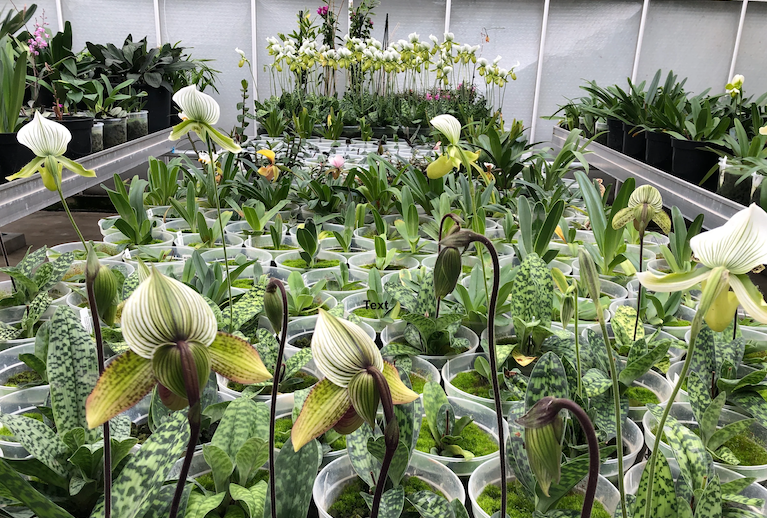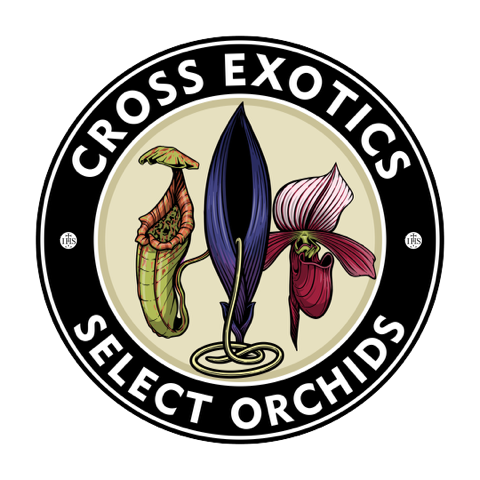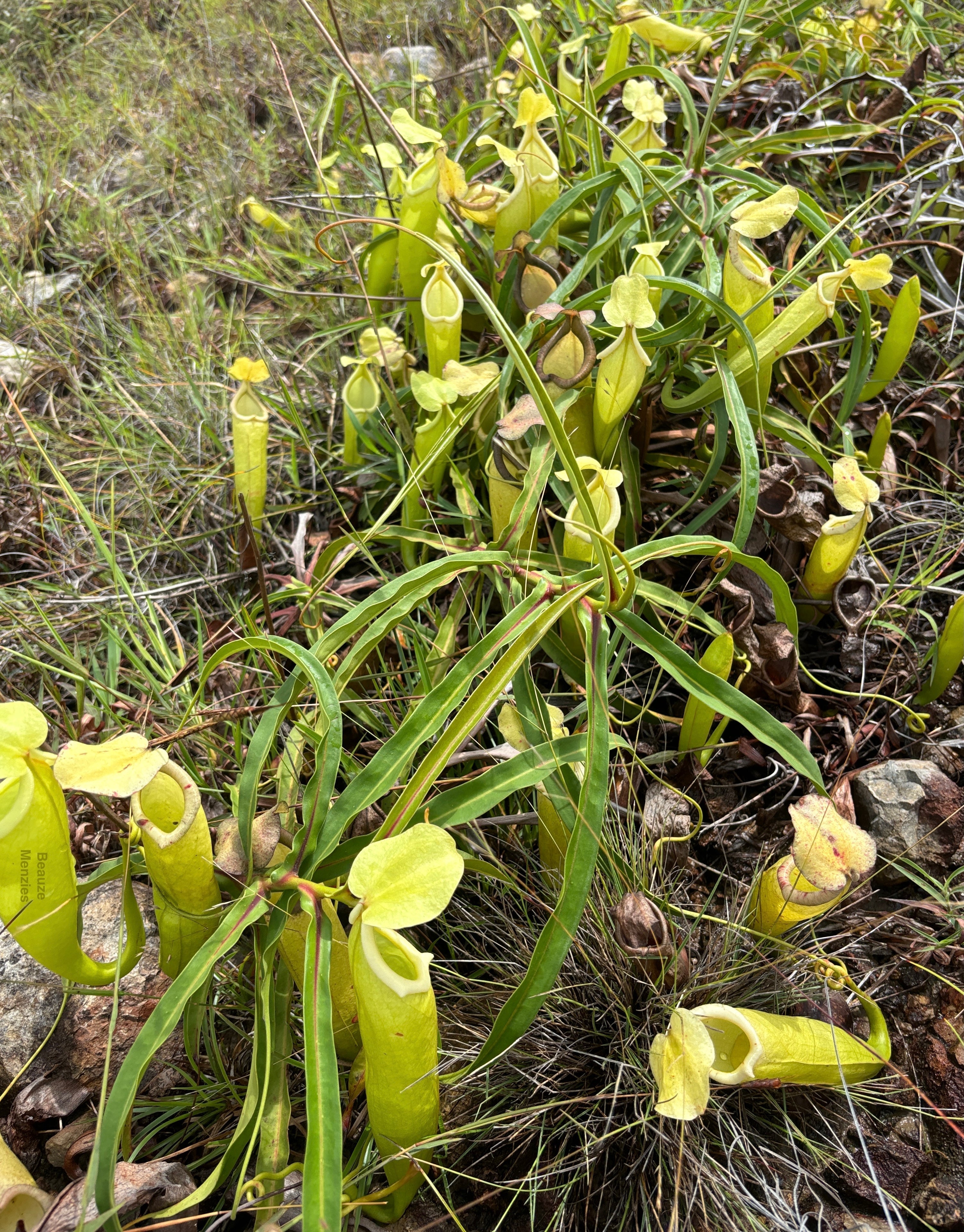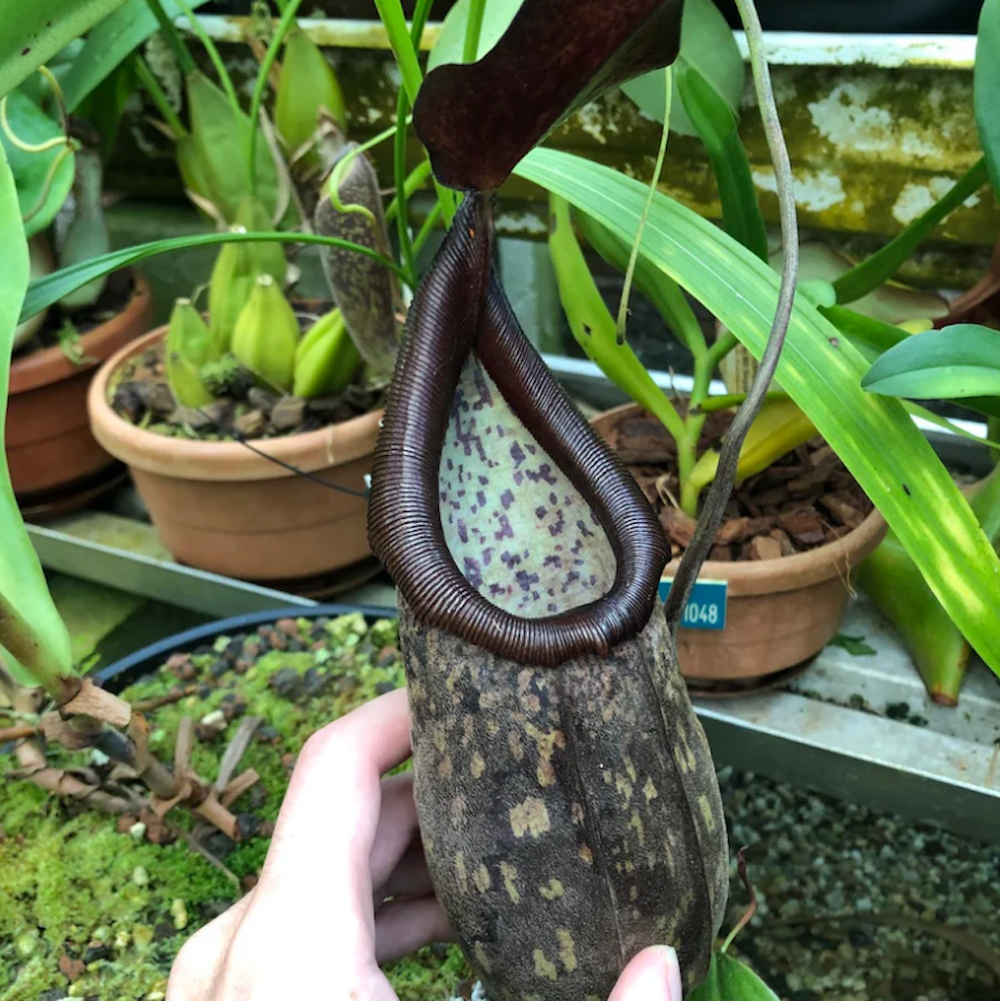Rockwool & Nepenthes

Pictured, Paphiopedilum growing in Xavier Loubresse's Greenhouse.
Considering the novelty of using rockwool as a substrate for the cultivation of Nepenthes, amongst other plants, I think a more detailed page on its use and history is necessary, to avoid undue confusion. I hope this helps clarify any questions that may exist on this media.
Rockwool is a green fiberglass-like product that conventionally has been used as an insulation material. As the name suggests, it is produced from basalt rocks which are melted, and whipped into fibers. Some suggest that the resulting product is not natural and could cause environmental damage upon disposal, however it should be noted that currently peat, Sphagnum, and coconut coir cause drastically more environmental issues and are technically more limited than rocks; coir in particular has caused massive issues in Sri Lanka while being promoted as an eco-friendly alternative to peat, to which it does not compare in truth.
Rockwool normally is not water absorbent and therefore the generic type is not useful for the cultivation of plants. However, Grodan, a European rockwool manufacturer produces a water absorbent type in various sizes that is quite useful in the cultivation of plants, their primary market being for hydroponics use. With this established, it is time to go into the history of rockwool’s use in the exotic plant world, specifically orchids.
Background:
Xavier Garreau de Loubresse of Select Orchids in Holland is the only commercial nursery to use rockwool cubes exclusively for the cultivation of numerous genera of orchids, aroids, and Nepenthes amongst other species. Xavier is known in the orchid world as an expert orchid grower, specializing in and supplying the majority of Paphiopedilum, slipper orchids, sold in Europe. This challenging genus is of particular interest because its range is sympatric with Nepenthes and cultivation is almost the same. Xavier does not appear to be widely known in the Nepenthes world which is surprising because he was Borneo Exotic’s advisor when they started years ago, and also was Besgrow’s technical advisor – the company that produces the coveted “New Zealand Sphagnum” so prized by Nepenthes growers. With decades of such experience, he has developed many unique methods of growing exotic plants to perfection including inventing the process of soaking coco coir with Calcium and Magnesium to exchange locked Sodium and Potassium salts (a process well established now in hydroponics and orchids but unknown in Nepenthes), and of particular interest, using rockwool.
The following information on rockwool’s history is based on communications with Xavier Loubresse and the following links, the latter being summarized in English here:
https://www.theguardian.com/lifeandstyle/2022/sep/18/get-growing-with-rock-wool-an-old-tip-newly-learned
https://www.youtube.com/watch?v=TUYB4F6jnp8
In the mid 90s Grodan made a special offer to the famous Eric Young (now the Eric Young Orchid Foundation) and Hans Christian in Denmark to produce a special one-time production of rockwool for the cultivation of orchids. The result was the manufacturing of only 80 sq meters of a special two-part flaked rockwool using lignin additives to stabilize the PH, never to be produced again. This rockwool worked wonderfully on Paphiopedilums but the stocks were quickly sold out and that was the end of that.
Due to this supply running out, it was back to the conventional pine bark, mixed with a bit of coco fiber. At that time coco had started to reach the market and was simply a waste product that had been piling up literally from mature coconuts in Sri Lanka. This coconut husks had been sitting around in the open air piles since the 50s, the result was a very durable, long lasting, and clean media. When coco coir began to catch on, these ancient stocks ran out and coconut plantations switched to selling new husks from soft green coconuts used for coconut milk, or water. The quality of the product as a result plummeted, as the new coco husk was more comparable to using lettuce as a media and unsurprisingly it would decompose quickly, rotting. At this point the coir fad was fully underway and many did not notice the change in quality. Contrarily, the fresh coco husk contained high amounts of hormones (naturally because it is part of a seed) which stimulated fantastic root growth initially but would end up as a disaster due to Sodium toxicity amongst other issues (Coco is unique for containing insoluble Sodium compounds that normal washing will not remove, therefore a low EC is deceiving). The end result was many orchid nurseries, including AnTec which promoted coco use, abandoned it after heavy loses. It would appear that Nepenthes are more Sodium tolerant since this is not as problematic an issue as with orchids. However, it should also be noted that the most famous Nepenthes nursery using coco coir, Borneo Exotics, steam sterilizes their coco based on Xavier’s recommendations, this still was true as of Rob Cantley’s conversations during his visit to Florae in 2021. The sterilization kills fusarium and stabilizes the Sodium toxicity to a manageable issue if heavily watered. So heavily watered in fact that BE uses an incredible 6,000 gallons per day of ground water to water their Nepenthes.
A review of the stunting caused by coco coir:
https://digitalcommons.usu.edu/cgi/viewcontent.cgi?article=1000&context=cpl_hydroponics
AnTec Lab’s flushing procedure and further explanation of how flushing with pure water only leaves as much as 2/3rd of the Sodium and Potassium remaining in Coco (lab tests were performed by XL, uncredited):
https://web.archive.org/web/20150820081512/http://ladyslipper.com/coco3.htm
Another substrate, peat became restricted as well. The German peat was the highest quality and could be used to grow orchids which conventionally need a very “light” media. This peat could be used in a few ways including growing Paphs in “mud” a technique Xavier and German orchid grower Popow used. Due to regulations the harvest and export of German peat was practically banned and growing in mud became an impossibility because lower peat grades rotted too fast. Due to the need for large quantities of high-quality growing media (decomposition and lack of repotting organic medias slows plant growth) and options for such a media running out, Xavier contacted Grodan asking if they could produce the special rockwool batch they had made for Eric Young again. However, it was impossible since Grodan stated it was too expensive and they had gotten rid of the necessary equipment. Grodan had instead began producing pure rockwool cubes for hydroponics tomatoes. While useful for tomatoes as a root stabilizer and nothing more, it was very difficult to use for growing orchids due to PH instability. This PH problem was not an issue for hydroponics due to the high quantities of nonstop daily watering which corrected the PH problems, but this was not possible for orchids that would only be watered a couple times per week in a pot rather than a hydroponics system.
Besgrow’s Orchiata line was proving very high quality, so durable that it would not decompose for over 8 years of use with a predicted lifespan of 15 years, rendering repotting only necessary when the plants outgrew the pot. The orchiata was made from high quality Pinus radiata bark from mature trees harvested for furniture production, but once again production changed and the supply changed to younger paper pulp trees which produced a shorter lasting bark, but still good for 3-4 years of use. However, like coco, its reputation was now set at this time and still is to this day as a “high-quality product” despite quality having dropped substantially. The parent company to Besgrow, “Pacific Wide,” more recently sold the company to “Dalton’s.” The size of the bags sold was reduced and the price per bag increased substantially, this change is still being seen with the Besgrow Sphagnum which has become increasingly rare as the wholesale price skyrockets forcing many Nepenthes growers to switch to coconut.
http://www.orchid.or.jp/orchid/people/tanaka/cult/Brachy/enBrachy.html
All this considered, it was clearly necessary a stable alternative media was necessary especially as some pine bark batches were ending up phytotoxic (Pines produce many compounds that can kill other plants if harvested improperly, a particular challenge for anyone trying to use fine fresh pine for Sarracenia). Many years had passed so Xavier purchased some more rockwool cubes to check if they had changed in any way. Surprisingly, the PH issue was gone. The PH on the cubes was neutral and therefore useable for orchids, furthermore the price was cheaper than pine bark. Apparently, Grodan had finally changed the manufacturing process from using Calcium carbonate (which turned into Calcium hydroxide, aka slaked lime, during the process) to using Ammonium carbonate which completely evaporates during the process leaving no PH issues. Finally, the use of rockwool was a real possibility.
Advantages:
Rockwool has since been promoted by many growers as their own idea. Hopefully, the above summary sets that story straight. It was upon meeting Xavier that he suggested that I try rockwool cubes due to the difficulties I had found with the inherit inconsistency of coco coir. Some batches of coco, from the same source, would be the right texture while other batches were mushy coir, and a complete waste of money. After seeing the best grown plants I’ve ever seen in his greenhouse, it was clear that this switch to rockwool had to be made. It should be noted by anyone wishing to order rockwool to make sure their rockwool cubes is from batches made the last few years, I found one source was still selling the old batch with PH problems.
Rockwool as a manufactured product is always consistent and overall affordable compared to most alternatives, the Grodan rockwool cubes being primarily of interest since it can be used in the same manner of coco chips or pine bark. There is also rockwool chunks, but they are a bit too large. The flat sheets of rockwool can also be useful for sprouting small seeds like Nepenthes that would otherwise fall into gaps. The media is void of organic material and therefore is a very clean substrate that lasts for years unless it compacts too much eliminating the need for repotting unless the plant outgrows the pot. It is also lightweight, a huge advantage for two reasons, first large pots are easy to move, a real issue with genera like Amorphophallus, and second the high airiness prevents root suffocation. The larger the pot, the airier the rockwool will stay, tending to compact faster in small pots. Plants should always be potted using wet, not dry, rockwool. This prevents sinking of the substrate after wetting and potential root damage.
The lack of organic material does mean the roots need time to adjust as it is different than organic medias, a process often taking a bit longer than a repot from Sphagnum into Coco etc. Aroids, including Amorphophallus, Begonias, ant plants, etc. all adjust relatively quickly to rockwool and do very well; slower genera understandably take longer. Many well-known Amorphophallus growers like Steve Jackson in fact use rockwool with great success after Xavier Loubresse’s flowering of the highly desirable Amorph. pendulus for the first time ever in cultivation. The relatively inert nature of this media also means it is free of fungal issues like fusarium which are an issue with coco, one only has to make sure to use an appropriate fungicide when first potting into rockwool to kill off any fungus on the existing plant’s roots.
Many people do not like the appearance of rockwool, especially when it grows algae on the surface. However, this algae and later moss, encourages better growth and should be promoted as long as the media is not kept saturated. The “star moss” which forms makes a more attractive appearance and in rockwool does not create the annoying root entanglements that occur in other medias, however for seedlings it should still be controlled.
Rockwool is overall free of available nutrients which for commercial growing is perfect as it allows exact fertilization, however for hobby growing this could prove more difficult and is an issue to hopefully be resolved in the future. Pure water should never be used for watering, some ppm is necessary to prevent root stress. Conventional medias like Sphagnum are actually not inert, after all they are made from plants, and plants hyperaccumulate nutrients. However, the overdependence on TDS meters (EC meters) have created a myth that Sphagnum, kanuma, etc. are nutrient free, what growers do not realize is that the media’s CEC (Cation Exchange Capacity) grabs and holds nutrients from dissolving into the pure water used for such tests, giving a false test result. This is the simple reason why nutrients don’t wash away from rain into the ocean - if it wasn’t for CEC we couldn’t grow vegetables outside. The same is true of the substrates we use for exotic plants. I think this should be an easy concept to understand and can be elaborated later.
The last concept that requires a brief mention is PH. As said, rockwool is now PH neutral and has little PH buffering, meaning it can fluctuate widely. Many growers have an idea that Nepenthes need an acidic media, this is true, but few people can say what PH that is or what their current PH is. For reference, PH is a measurement of Hydrogen ions in a solution, a PH of around 3 is roughly equivalent to vinegar – clearly vinegar on a plant’s roots doesn’t sound like a good idea. The PH range makes some nutrients easily absorbable by the plants and others difficult to absorb, this is the reason why plants in very old sphagnum or other medias (organic medias typically acidify over time) can get a growth spurt. It’s not because the roots enjoy being toasted by acidity but because certain micronutrients are easier to absorb at such low PHs, and thus deficiencies are partly remedied – and the plant’s growth resumes to normal. PH issues are often responsible for stunting and slow growth. As mentioned prior, Borneo Exotics uses hard water (not pure!) buffered to PH 5.5 using nitric acid. I hope this brief overview helps increase the understanding and use of this growing media.



